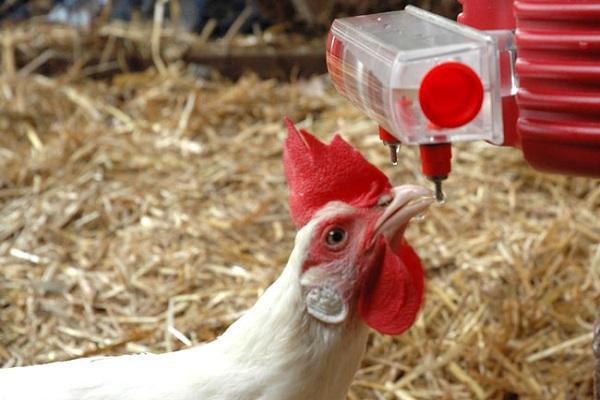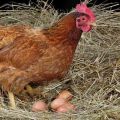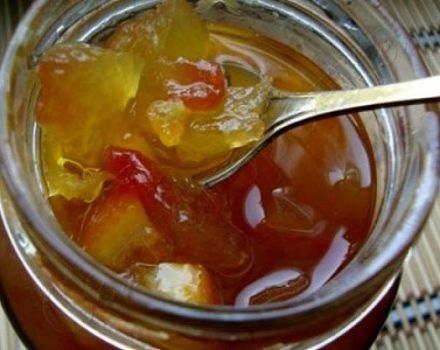How many days or days does it take for a hen to hatch chickens, recommendations for the selection of eggs
Breeding chickens is a profitable and useful business. Many people now breed chickens to have dietary eggs on the table. In summer, chickens provide their hosts with fresh eggs. If you wish, you can put the hen on the incubation material to have a brood.
Content
The article tells about how much time of day a hen incubates chickens, about the features of the incubation process.
When do chickens lay?
Chickens have a biorhythmic cycle by nature, this determines the slowdown or complete cessation of egg-laying in winter. In the spring, chickens begin to lay again. With the onset of cold weather, birds begin to molt, in connection with this, egg production in layers decreases, although it does not stop completely. Some breeds of chickens continue to run well in winter, if they are provided with warmth and light in the room.
It is known that chickens are of meat, egg and meat-and-meat directions.
The initiation of egg laying in chickens depends on their breed. Egg breeds begin to lay earlier than others.
The start of lay depends on the time of hatching. Those birds that hatched in winter and spring begin laying earlier than others, and later than others - the summer brood. Chickens of egg breeds begin to lay in 17-19 weeks. Meat breeds after 22 - 23 weeks. Meat breeds - after 28 weeks.

How to choose a good brood hen?
As a brood hen, one should choose a healthy, normally developed individual, which showed good egg production during the season. Only then can you get good chicks. First you need to observe the behavior of the herd of poultry. A hen with an awakened maternal instinct stops rushing, rarely leaves the nest into the yard, resists when trying to drive it away. Feathers and down can be found in the nest; it clucks constantly with characteristic sounds. In addition to these signs, you can check the body temperature, it is slightly elevated.
A chicken with such signs can be checked in another way. Within 2-3 days, plant it in a nest with laying eggs made of foam or other materials. A bird with a good incubation instinct will sit quietly on dummies.

This means that it is suitable for laying hatching eggs. Experienced poultry farmers identify the brood hen by its comb, which turns from pale pink to bright red and increases in size.
Important! If there is no suitable individual among the chickens, and the number of birds needs to be increased, then the instinct of motherhood can be forcibly awakened.To do this, a healthy and thoroughbred hen (middle-aged) is planted in a nest, then covered with a lid for 3-4 days, releasing to eat and drink. In most cases, the bird begins to give signals of readiness for motherhood..

How many eggs can a chicken hatch at a time?
The number of eggs to be placed under the nest depends on the size of the hen, which is determined by the breed of bird. The eggs should be placed in a single layer under the hen and she should cover them with the body in a sitting position in the nest. 13-15 eggs will fit under one large chicken.
How to put a hen on eggs
Before planting a quail on eggs, you need to select a good lining material, prepare a place for a nest in a warm and safe room.
Egg selection
There are requirements for the selection of eggs for incubation:
- Eggs should be taken from healthy layers without signs of disease.
- The laying hen must show signs of puberty.
- Eggs for lining should be taken from under the chicken only fresh, after laying they remain fresh for up to 6 days. The incubation material must be clean and free of cracks.
- Select backing material of the same average size.
- To accurately determine fertility, eggs can be checked with an ovoscope.

Important. The egg shell has a porous structure. Do not wash or wipe them before laying under a hen.
Site preparation
After you have found the hen and the required number of eggs, you need to prepare the nest for incubating chickens.
The nest can be of different shapes, it should be cozy, preferably wooden. You can make it from willow twigs, weave it from a bundle with dimensions 60 by 50 cm, with a depth of about 30 cm. The bottom of the box should be covered with a bedding of dry straw, leaving a recess in the middle for the eggs so that they do not roll to the sides. A box with a hen is placed in a dark, quiet place not high from the floor.

How long does a laying hen hatch eggs?
This question is asked by many novice poultry farmers.
The hen sits on the clutch around the clock for 21 - 23 days, if it is provided with good conditions: warmth and safety.
If the bird does not leave the nest without getting up, sits, then once 1-2 days it can be removed from there. The eggs should not cool down at this time. So that the chicken embryo does not die, it is worth covering them with a rag.
Change the bedding if necessary. Sometimes you can see that the chicken rolls out the testicle from the nest, which means that the embryo of the egg froze. Such defective eggs must be removed from the hen.

Incubation process
The process of incubating chickens with a chicken has its own characteristics. The chicken warms the eggs with the heat of its body, which is within +37.8 degrees. The hen naturally has an instinct to turn them over independently, so that all eggs are warmed up evenly. She also moistens the testicles with saliva.
The brooding process is not continuous, the brood hen leaves the nest in the yard to drink water, nibble on food, and sometimes it "bathes" in the soil, spreading its wings.
Laying hen care
After the hen sits on the eggs, the incubation time begins from this moment. At this time, the hen must be looked after. A brood hen that has perched on eggs usually does not leave the nest with eggs, she warms future chicks, turning over the incubation material, and takes care. She even forgets about food and drink.

However, many individuals are weaned from the nest, go out to nibble on food, drink water. Therefore, a feeder with grain and a drinker with clean water should be placed near the nest. There should also be a box with ash or soil for "bathing" the bird, as well as gravel or shells. If it does not leave the nest for a long time, so that the brood hen does not become exhausted and does not die, it must be carefully removed from the nest for eating. The bird will stay for about 10-15 minutes for all these procedures.
While the chicken is absent, eggs can be checked for defective eggs. If so, they are removed.
How to wean a chicken from hatching eggs
As mentioned above, chickens have a natural biorhythm, according to which the instinct of motherhood awakens in domestic birds. It does not always match the needs of the person. Summer has passed, autumn is coming, and several hens are showing signs of hatching. If there are no appropriate conditions, for example, heat, the chicken will not be able to warm up the chicks, they will die. How to wean layers? Experienced poultry farmers have proven methods with which you can wean mumblers from incubation. The most common and proven method in practice is bathing a hen in water. To do this, the body is dipped into a barrel of cold water, after which it stops clucking. With a sharp hypothermia, the chicken experiences tremendous stress.

Some owners place such a hen in an empty box without bedding and eggs and for several days. A positive result is obtained, the hen is weaned from incubation. This method is also used in villages: a few drops of vodka are poured into the bird's beak.
Tips and tricks from experienced poultry farmers
To prevent rats or other pests from interfering with the incubation of chickens, you need to put the nest in a safe place and constantly check it.
Some chickens secretly build nests by hiding in nettles or in bushes that are not intended to hatch at all. It is impossible to take care of the laying hen there; it can remain in the rain. After finding such an individual, experienced poultry farmers transfer a bed with eggs from under the hens to the chicken coop at night. The hen will be aggressive. To prevent the kvochka from leaving the nest, it is necessary to cover it with a box (they do it a few days before the transfer). When the nagger gets used to this phenomenon, you can move it to a new place.

Novice poultry farmers should know that the hen must be intensively prepared for incubation.
2-3 two to three weeks before the planned forced planting on eggs, the hen should be fed with complete grain feeds, in which there is a sufficient amount of protein, proteins and vitamins. Additionally, you need to give chopped greens.
If you take up the breeding of chickens, then you can quickly see the profitability of this business.









